How to plant lilies in the spring so that they bloom well?
According to the rules of agricultural technology, the bulbs of most types of lilies are planted in the ground in the fall - this time is more consistent with the natural life cycle of the plant. However, the trend of recent years is the spring planting of corms. In this case, not only heat-loving Asian and LA hybrids are planted, but also other species, types. This is due to both breeding achievements and the fact that in winter, planting material for lilies can be bought much cheaper - there are sales of the remnants of the autumn season. Among such bulbs, already sprouted ones are often found. And the question arises - how is the planting of lilies with sprouts in spring?
How to keep the bulbs until spring?
First of all, the purchased bulbs are carefully examined, the scales with mechanical damage, dry, covered with dark spots, with other deviations are removed. Then they are treated with antifungal drugs, dried.
You can store them until the warmth in your home refrigerator, having previously transferred them with moistened peat, coconut fiber, moss or vermiculite and packed in plastic bags with holes for air circulation. The onions must be laid with their bottom down - in case the awakened sprout does not deform.
For storage of corms, a separate compartment is allocated in the vegetable compartment of the refrigerator. Fresh vegetables and fruits stored nearby must be tightly wrapped in plastic: the ethylene they release has a detrimental effect on lilies.
From time to time, at least once every two weeks, the bags are opened, if necessary, the cushioning material is moistened, and the bulbs are checked for signs of rot, mold. If such problems occur, the corms are cleaned of affected scales, treated with fungicides, and stored again.
What to do with sprouted corms before planting?
If, during the next check of the planting material, germinated corms are found, they must be planted. The germination process cannot be stopped, and without soil the bulb will be depleted, there will be no use from it. Also, newly acquired lilies with sprouts cannot be stored.
Corms with sprouts are planted in ordinary pots for indoor flowers. It would be even better to choose a transparent container for them, like a large plastic glass or a cut bottle: it is easier to observe the condition of the roots, it is not difficult to make additional holes for air access to the roots in the walls. Transparent walls, moreover, will allow you to more accurately regulate watering, since corms are equally negative about waterlogging and overdrying.
Any soil mixed with peat or humus is suitable for growing. The main requirement is moderate fertility and looseness. You can use a commercially available generic or special for liliaceae. For better growth and preservation of the bulbs, the soil is covered with layers in the pot: first a layer of soil, then clean river sand, in which the lily is placed with a sprout straight up, then again the soil.
Before planting, the bulbs are etched in any disinfectant solution - manganese, "Fitosporin", etc. - for 30 minutes. They also disinfect soil and sand.
The bulb in the pot is not buried, but planted so that the beginning of the sprout is at the level of the soil. If the sprout is very small, just hatched, its very tip is left on the surface.
Keep the pots of bulbs on a cool well-lit windowsill. Watered every 5-7 days.It is not necessary to feed the bulbs during this period.
In a container with soil, lily bulbs are kept until spring, when the time is right for planting them in a flower bed.
Planting bulbs with sprouts
In spring, lilies begin to be planted on flower beds when warm weather is finally established, and the risk of return frosts is reduced to zero. In the southern regions this is the second half of April, in temperate latitudes - mid-May, in the Urals and Siberia, planting is carried out in the first decade of June.
More precise dates are determined by the condition of the soil at the landing site. It should warm up, become free-flowing, loose, moderately moist. In any case, sprouted bulbs are planted a week or two later than non-sprouted ones.
To plant a lily, a planting site is chosen corresponding to its type - some love the sun and do not tolerate even a hint of shadow, others, on the contrary, open up in all their glory, being shaded. For all lilies, it is important that the place is not blown through by through winds, but at the same time it is well ventilated.
The soil for planting is also made up and refined according to varietal characteristics. Common to all species is fertile, light soil with sand so that moisture does not linger.
Algorithm for preparing the soil for planting sprouted lily corms
- The soil is dug to a depth of 40 cm. If necessary, arrange drainage, ennoble the earth by introducing baking powder and bringing it to the required level of acidity (depending on the type of lilies).
- For large bulbs with sprouts up to 15 cm, planting holes are dug 20 cm deep, for small ones - 12-15 cm.
- At the bottom of the holes, a drainage layer of broken brick, expanded clay or medium-sized pebbles is laid out.
- If the soil is poor, the soil dug out of the holes is mixed with a small amount of compost or humus.
- A small amount of the prepared soil mixture is poured onto the drainage layer, a little superphosphate and potassium sulfate are added.
- Spill the well with a little water.
- A layer of sand is poured, forming a small mound from it in the center of the hole.
- To protect against disease, the bulb is powdered with wood ash and placed in a hole at the top of a sandy mound, spreading the roots along the slopes.
- The onion is poured, poured abundantly with water with the addition of Epin.
It is preferable to plant tubers with long, more than 15 cm sprouts in 10-cm grooves, laying them on a barrel. Typically, these long shoots produce Asian and LA hybrids. In a couple of weeks, the shoots will take an upright position, this time is enough to completely exclude frosts, destructive for heat-loving sissies.
Features of caring for bulbs with sprouts
Usually lilies planted in spring bloom poorly in the first year - they need time to grow stronger. If you really want them to bloom in the first summer, they pay more attention to them than when planting non-germinated bulbs. To increase the chances of flowering, these plants are fed more often than others.
Top dressing is applied according to the schedule:
- calcium nitrate - 2 times, 10 and 20 days after planting;
- potassium and phosphorus-containing fertilizers - a month after planting, then every 10 days until buds appear;
- Kalimagnesia is applied every 10 days from the beginning of bud formation, completed a week before flowering;
- potassium monophosphate after flowering is applied twice.
Lilies are fertilized every 10 days only with liquid formulations.
The main rule of dressing is to prevent overdose. Often, summer residents, instead of chemicals, feed problem plants with wood ash or an infusion of onion peels, which act more gently. Infusions are not capable of harming the corm. Lilies are not fed with organic matter, so as not to provoke fungal diseases.
Watering is no less important, since without a sufficient amount of moisture, the lily simply cannot fully bloom. However, care should be taken so that excess moisture does not provoke the development of fungal diseases.
Other questions
When preparing lily bulbs with sprouts for planting, summer residents often wonder whether they will wait for luxurious flowers in the current season. If storage, growing, planting in flower beds and further care were carried out according to all the rules, lilies will necessarily form buds and bloom. But, most likely, not as abundantly as they would bloom if planted in a normal state on time.
Problems with flowering arise if the summer after planting lilies with sprouts happened to be cold and rainy. Experienced summer residents, under such circumstances, do not allow the buds to open at all, cutting them off immediately after they appear.
Most garden centers hold a sale of lily planting stock in the spring. In this case, experienced flower growers recommend buying lilies with sprouts: they indicate the vitality of the bulbs.
Another thing is that problem plants will not give offspring in the first season. A bulb that has sprouted in anticipation of its buyer is already to some extent depleted, plus summer flowering - it will need a full dormant period to fully recover.
It is quite possible to grow a healthy plant that blooms with high quality and gives children in a timely manner from a bulb with a sprout. Correct planting and increased attention to flowers in the first season guarantee a successful replenishment of the collection of lilies at their summer cottage.
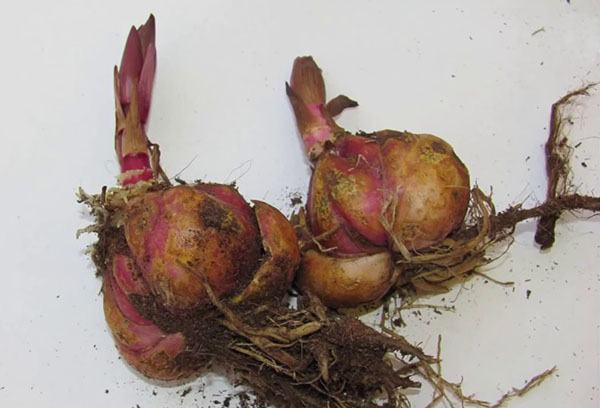
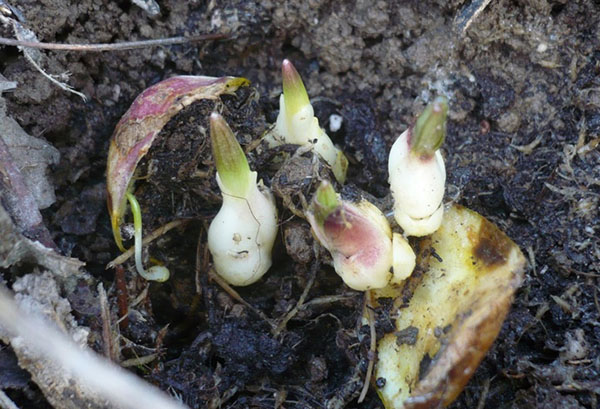
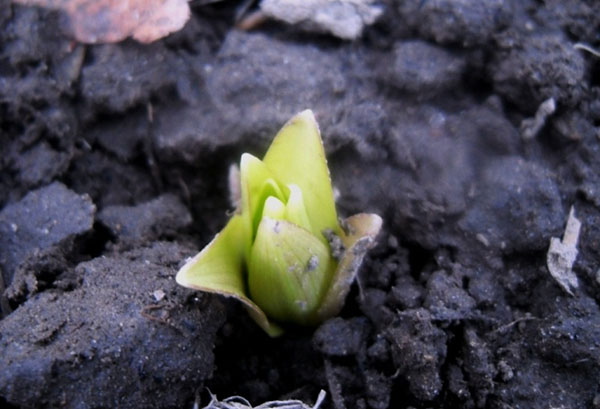
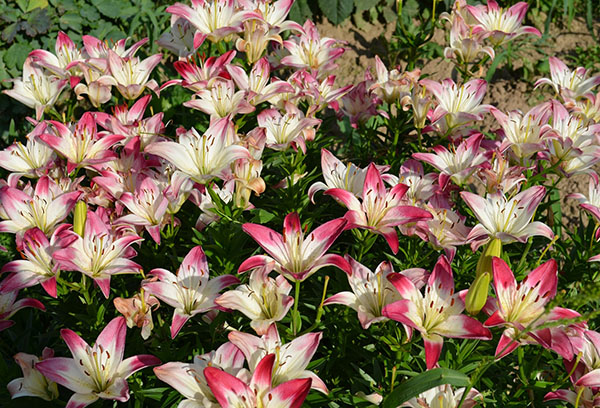

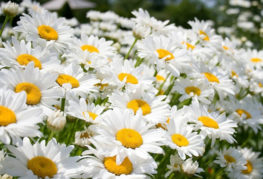




and will be published shortly.